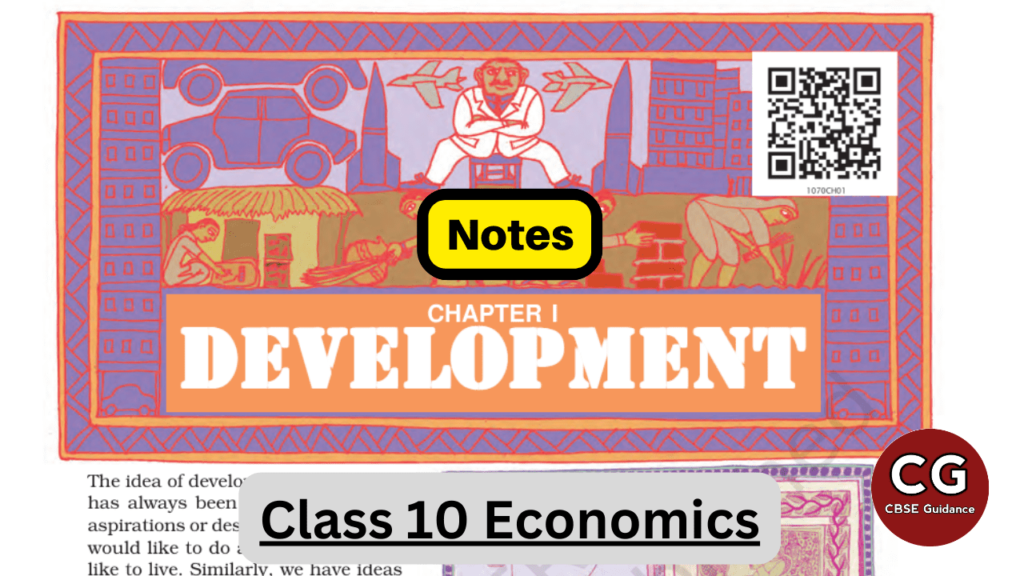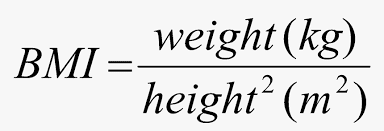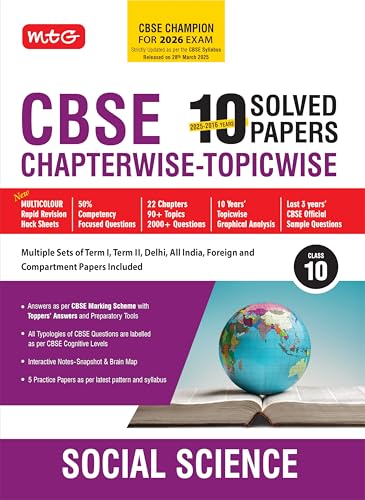Studying Class 10 Economics Chapter 1 Development can be overwhelming, especially if you have a lot of material to cover. These simplified notes provide a concise and effective way to study for your exam, covering key topics such as economic development, its goals, and sustainable development. Whether you're short on time or just looking for a more efficient way to study, these notes can help you prepare for your exam and achieve academic success. You can also download these notes in pdf format and take a printout of it and study from it.

| Subject | Social Science (Economics) |
| Class | 10 |
| Board | CBSE and State Boards |
| Chapter No. | 1 |
| Chapter Name | Development |
| Type | Notes |
| Session | 2025-26 |
| Weightage | 4 marks |
"Don't watch the clock; do what it does. Keep going."
- Sam Levenson
Chapter 1 Development Class 10 Notes
Development: It is a situation that can fulfill the aspirations or desires of people. It is the progress or improvement in the lifestyle of the people.
Two aspects of development are:
- Different people can have different development goals.
- What may be development for one may not be development for others.
Different people can have different development goals
It is because the life situations of people are different. People see things that are most important for them or that can fulfill their aspirations or desires. For example, the development goal of a boy from a rich urban family would be to get admission to a reputed college whereas the development goal of a girl from a rich urban family would be to get as much freedom as her brother.
What may be development for one may not be development for others (i.e., Development Goals can be conflicting):
- At times two people or groups of people may seek things that are conflicting. A girl expects as much freedom and opportunity as her brother and he also shares in the household work. Her brother may not like this.
- Similarly, to get more electricity, industrialists may want more dams but this may submerge the land and disturb the lives of people who are displaced, such as tribals.
Development Goals of Different Categories of Persons:
| Categories of Person | Development Goals |
| Assured a high family income through higher support prices for their crops and through hardworking and cheap laborers; they should be able to settle their children abroad. | i. More days of work and better wages ii. local school is able to provide quality education iii. for their children iv. there is no social discrimination v. they too can become leaders in the village |
| Prosperous farmers from Punjab | i. Assured a high family income through higher support prices for their crops and through hardworking and cheap laborers ii. they should be able to settle their children abroad. |
| Farmers who depend only on rain for growing crops | i. To have irrigational facilities ii. crop insurance at less premium, iii. water facilities of life for them as well as their children |
| Landless rural laborers | i. They would like to have more days of work and better wages. ii. local schools to provide quality education to their children iii. there should not be any social discrimination so that they too can become leaders in the village. |
| Urban unemployed youth | i. Opportunity for higher education ii. availability of an office job iii. a self-owned house |
| A boy from a rich urban family | i. Education and Skill Development to enhance future employability and economic prospects. ii. Entrepreneurship and Innovation to create new business ventures and contribute to economic growth. iii. Financial Literacy to ensure long-term financial stability and growth. |
| A rural woman from a land-owning family | i. She gets as much freedom as her brother and is able to decide what she wants to do in life. ii. She is able to pursue her studies abroad |
| An adivasi from Narmada valley | i. No social discrimination ii. year-round employment iii. school education for children iv. PDS shop in his village. |
Goals of Development:
- Income
- Equal treatment
- Freedom,
- Security
- Respect for others.
- Discrimination free society
For development, people look at a mix of goals: It is true that if women are engaged in paid work, their dignity in the household and society increases. However, it is also the case that if there is respect for women there would be more sharing of housework and a greater acceptance of women working outside. A safe and secure environment may allow more women to take up a variety of jobs or run a business.
How to Compare Different Countries or States?
For comparing countries, their income is considered to be one of the most important attributes. This is based on the understanding that more income means more of all things that human beings need. Whatever people like, and should have, they will be able to get with greater income. So, the greater income itself is considered to be one important goal.
However, for comparison between countries, total income is not such a useful measure. Since, countries have different populations, comparing total income will not tell us what an average person is likely to earn.
Average Income/Per Capita Income: The average income is the total income of the country divided by its total population. The average income is also called per capita income.
- In World Development Reports, brought out by the World Bank, Per Capita Income is used in classifying countries.
- Countries with a per capita income of US$ 49,300 per annum and above in 2019, are called high-income or rich countries.
- Countries with a per capita income of US$ 2500 per annum or less are called low-income countries.
- India comes in the category of low-middle-income countries because its per capita income in 2019 was just US$ 6700 per annum.
Disadvantages of using Average Income as a criterion to compare countries:
- Average income hides the disparity.
- Average income does not tell us the distribution of income among people.
- It is just a material criterion for the comparison.
Comparison of Haryana, Kerala, and Bihar (on the basis of average income/per capita income):
| State | Per Capita Income for 2018–19 (in ₹) |
| Haryana | 2,36,147 |
| Kerala | 2,04,105 |
| Bihar | 40,982 |
- We find that of the three, Haryana has the highest per capita income and Bihar is at the bottom.
- So, if per capita income were to be used as the measure of development, Haryana will be considered the most developed and Bihar the least developed state of the three.
Comparison of Haryana, Kerala, and Bihar (on the basis of other criteria):
| State | Infant Mortality Rate per 1,000 live births (2018) | Literacy Rate % 2017–18 | Net Attendance Ratio (per 2017–18 100 persons) secondary stage (age 14 and 15 years) 2017–18 |
| Haryana | 30 | 82 | 61 |
| Kerala | 7 | 94 | 83 |
| Bihar | 32 | 62 | 43 |
- Infant Mortality Rate (or IMR) indicates the number of children that die before the age of one year
as a proportion of 1000 live children born in that particular year. - Literacy Rate measures the proportion of the literate population in the 7-and-above age group.
- Net Attendance Ratio is the total number of children of age group 14 and 15 years attending school as a percentage of total number of children in the same age group.
- The first column of the table shows that in Kerala, out of 1000 children born, 7 died before completing one year of age but in Haryana, the proportion of children dying within one year of birth was 30, which is nearly three times more than that of Kerala. On the other hand, the per capita income of Haryana is more than that of Kerala.
- The last column of the table shows that about half of the children aged 14-15 in Bihar are not attending school beyond Class 8. This means that if you went to school in Bihar nearly half of your elementary class friends would be missing.
Public Facilities:
Public facilities are those provided by the government instead of individuals or private sources. For this reason, they may be either highly subsidized or totally free of cost. They are important because many persons do not have enough income to be able to avail of facilities provided by the private sector resulting in difficulties faced like inadequate healthcare, poor nutrition, lack of education, etc. The utility of two public facilities available in India are:
- The public distribution system (PDS) provides fair average quality food grains and other essential items to the weaker section of the population at subsidized prices.
- Health care in government hospitals and dispensaries is provided to all at a subsidized rate. This includes outpatient as well as hospitalization facilities.
Money in our pockets cannot buy all the goods and services that we may need to live well.
- Money cannot buy us a pollution-free environment.
- Money cannot buy us a disease-free life and might not be able to get protection from infectious diseases.
- Besides money, people also like to have equal treatment in society, freedom, dignity, and honor in their lives, which money cannot buy them.
Body Mass Index (BMI): Body mass index (BMI) is a person's weight in kilograms divided by the square of height in meters.

Human Development Index (HDI):
United Nations Development Programme has used the criterion of the Human Development Index to measure the development of countries. The human development index is a composite index of the achievements of a nation in terms of three important variables (longevity, knowledge, and standard of living, quality of life).
HDI is calculated on the basis of:
- Per capita income: It is calculated by dividing the total national income of a country by the total population.
- Life expectancy: It is the average expected length of life of a person at the time of birth in a country.
- Gross enrolment ratio for three levels: It means the enrolment ratio for primary schools, secondary schools, and higher education beyond the secondary level.
Human Development Report Vs World Development Report:
| UNDP's method of measuring development | World Bank's method of measuring development |
| i. UNDP compares on the basis of literacy rate, gross enrolment ratio, and health status of people. | i. World Bank compares on the basis of per capita income. |
| ii. It gives ranks to the countries according to their level of development. | ii. It divides the countries according to - rich or high-income countries - middle-income or developing countries - poor or low-income countries |
| iii. It is a wider concept as it includes other things besides income. | iii. It is a narrow concept. |
Comparison of India with its Neighbors:
| Country | Gross National Income (GNI) per capita (2011 PPP $) | Life Expectancy at Birth | Mean Years of Schooling of People aged 25 and above | HDI Rank in the world (2018) |
| Sri Lanka | 12,707 | 77 | 10.6 | 73 |
| India | 6,681 | 69.7 | 6.5 | 130 |
| Myanmar | 4,961 | 67.1 | 5.0 | 148 |
| Pakistan | 5,005 | 67.3 | 5.2 | 154 |
| Nepal | 3,457 | 70.8 | 5.0 | 143 |
| Bangladesh | 4,976 | 72.6 | 6.2 | 134 |
Note:
- HDI stands for Human Development Index. HDI ranks in the above table are out of 189 countries in all.
- Life Expectancy at birth denotes the average expected length of life of a person at the time of birth.
- Per Capita Income is calculated in dollars for all countries so that it can be compared. It is also done in a way so that every dollar would buy the same amount of goods and services in any country.
- Sri Lanka is much ahead of India in every respect.
- Nepal and Bangladesh have low per capita income than that of India, yet they are better than India in life expectancy.
Sustainable Development:
Development, at present, without harming the environment and also keeping it safe for future generations is termed sustainable development.
- Groundwater, which is a renewable resource, is getting depleted because of its overuse. People are facing the problem of a water crisis due to its indiscriminate use.
- The development that emerged from the fast industrialization leads to the cutting of forests and its result is a polluted- environment for the present as well as for future generations.
- Crude oil which is a non-renewable resource with limited stock is depleting gradually. So we need to use it wisely.
The present sources of energy that are used by the people of India are:
- Electricity
- Coal
- Crude oil
- Cow dung
- Solar energy
Hope you liked these Notes on Development Class 10 Economics. Please share this with your friends and do comment if you have any doubts/suggestions to share.



Plz provide sector of Indian economy and money and credit notes
Yes coming soon.. in this week
Sir,
Certain chapters in PD, notes and Questions have not yet been uploaded. Request if you can please upload
Regards
Sir how we can download these notes in pdf format? By the way these notes are very efficient.
How to Download PDF from CBSE Guidance Website
https://youtu.be/zjocgf0LzUM
is this enough for board